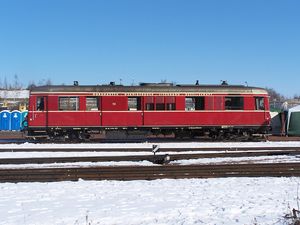NWE T 1 to 3
| NWE T 1 to T 3 | |
|---|---|
|
Side view T 3 in March 2006 in Gernrode
|
|
| Numbering: | NWE T 1 to 3 DR VT 137 561, 565, 566 DR 185 025 (until 1978) DR / HSB 187 025 |
| Number: | 3 |
| Manufacturer: | MAN * or Waggonfabrik Wismar (mech.) / BBC Mannheim (electr.) |
| Year of construction (s): | 1935 *, 1939 |
| Retirement: | T 1: 1969, T 2: 1967 |
| Axis formula : | Bo'Bo ' |
| Genre : | T 3: KD4i |
| Gauge : | 1000 mm ( meter gauge ) |
| Length over buffers: | 15,600 mm |
| Height: | 3450 mm |
| Width: | 2700 mm *, 2600 mm |
| Trunnion Distance: | 11,100 mm |
| Bogie axle base: | 1900 mm |
| Smallest bef. Radius: | 40 m |
| Service mass: | 35.5 t *, 34.5 t |
| Top speed: | 40 km / h *, 60 km / h |
| Installed capacity: | today: 242 kW, during construction: 300 kW (400 PS) *, 380 kW (520 PS) |
| Driving wheel diameter: | 800 mm |
| Motor type: | today: 6 cylinder turbo-diesel |
| Motor type: | today: Cummins M11I-R2 |
| Drive: | diesel-electric |
| Brake: | Suction air, compressed air since the conversion |
| Train heating: | Hot water (coke *, oil) |
| Seats: | 23 *, 0 |
| * Information for the T 1 | |
The T 1 to 3 are four-axle diesel-electric combustion railcars from the former Nordhausen-Wernigeroder railway company . The vehicles from the 1930s, designed as tow cars, were intended to make rail operations more efficient in times of low traffic.
history
The first railcar was built by MAN in 1935 with 23 seats, a matching sidecar was built by the company's own workshop. Each axis was driven by its own electric motor. The first experiences were positive, but the performance was not yet sufficient. The follow-up vehicles delivered by the Wismar wagon factory in 1939 received more powerful MAN engines. In addition, they were designed as pure towing cars without a passenger compartment, only with a luggage compartment. They were also able to pull four passenger carriages over the incline. The railcars had doors and a transition device on the end walls. The front wall of the T1 was straight, while the other two cars had a slight incline from the window area.
When they were taken over by the Deutsche Reichsbahn in 1949, they were given the numbers VT 137 561, 565 and 566. The VT 137 561 was transferred to the Spreewaldbahn in 1961 , where it was only in use for two years before it was just like the VT 137 565 was parked. In Wittenberge, the two railcars were scrapped in 1967 and 1969 and only the former T 3, which is still in existence today, accidentally received the wrong computer number 185 025 from the Deutsche Reichsbahn in 1972, which was only changed to 187 025 in 1978. The change was made pragmatically and only changed two digits, the series and the control number - because there were actually no other vehicles besides the T 1 of the GHE (187 001) and this railcar. Most of the time, however, it was shut down; there were no spare parts for the compressor of the compressed air system to start. At the DR, the ribbon windows were painted ivory, while the rest of the car body above and below the windows remained red.
It has been owned by the Harz Narrow Gauge Railways since 1993 and was restored to working condition in 1999 after more than twenty years of storage. He received a new diesel engine from Cummins , as it had also been used in the new railcars. In 2003 the electric motors were also overhauled. In contrast to the other existing railcars of the HSB, the railcar is painted a single color burgundy and is only used for special services. Only in 2007 did he come into plan service because of the revisions of the new HSB 187 016 to 019 multiple units.
The vehicle is currently parked after the deadline.
literature
- Horst J. Obermayer: Paperback German railcars . Franckh'sche Verlagshandlung, Stuttgart 1973. ISBN 3-440-04054-2 , p. 207.
- Gerhard Zieglgänsberger, Hans Röper: The Harz narrow-gauge railways . 1st edition. Transpress, Stuttgart 1999, ISBN 3-613-71103-6 , pp. 116-121 .

